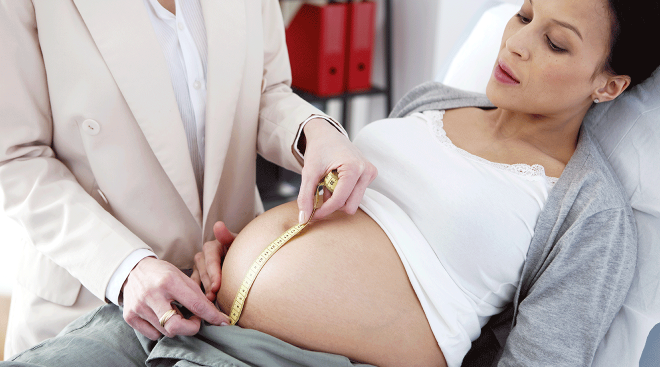What Happens if You Go Past Your Due Date?
You spend your whole pregnancy planning for baby’s arrival, arranging the nursery, gathering your gear and mentally preparing for motherhood. By the end of it, you’re tired, you’re achy and you’re focused on the finish line: Your due date. So when baby doesn’t make their big debut when expected, it can be frustrating to say the least. But (unfortunately) due dates aren’t precise schedules.
A pregnancy is considered full term at 39 weeks through 40 weeks, according to the American College of Obstetricians and Gynecologists (ACOG). For most women, their due dates were calculated by adding 280 days to the date of their last menstrual period, meaning they’re 40 weeks pregnant by their due dates. Pregnancy becomes late-term at 41 weeks, and postterm at 42 weeks and beyond. While only a small contingent of women (some say 3 to 5 percent) give birth on their actual due dates, the vast majority will deliver sometime between 38 and 42 weeks.
If you’re past your due date, just know this: You’re not alone. Plenty of women see their due dates come and go without meeting their newborn. Still, your doctor may want to change up your prenatal care a little from this point until you deliver. Here’s what happens if you go past your due date.
Due dates aren’t set in stone, so it could simply be that the calculation was a little off or baby just isn’t ready to come out yet, says Christine Greves, MD, a board-certified ob-gyn at the Winnie Palmer Hospital for Women & Babies in Orlando, Florida.
There are a few other factors that could be at play. “Women having their first baby are more likely to go past their due date in comparison to women who have had children before,” says Julie Lamppa, APRN, CNM, a certified nurse midwife at Mayo Clinic. You’re also more likely to go past your due date if you’re having a boy, you’ve been overdue with past pregnancies or you’re obese, Greves says. It’s also possible that you’re overdue because there’s a problem with the placenta or baby, but Greves says that’s rare.
When pregnancy extends to 41 weeks and beyond, the health risks for you and baby increase—but problems arise in only a small number of pregnancies. According to the American College of Obstetricians and Gynecologists (ACOG), most women who give birth after their due dates have uncomplicated labors and give birth to perfectly healthy babies. The possible health risks include:
• Baby may be bigger at birth, which can lead to interventions such as an assisted vaginal delivery or c-section
• Baby may stop growing along the normal growth trajectory, which would be a sign it’s time to induce you
• Amniotic fluid levels may drop, which can affect baby’s heart rate and compress the umbilical cord during contractions
• The chances of you experiencing severe vaginal tears and postpartum bleeding increase
• After 42 weeks, there’s a higher risk of stillbirth
For starters, don’t panic. Due dates aren’t definitive deadlines, and plenty of women find themselves in this boat. Every doctor’s office handles things a bit differently when you go past your due date, but here are some things they might do to ensure you and baby are doing well and to possibly help labor along.
Check your cervix
Your doctor may want to do a cervical exam at 40 weeks (i.e., your due date) to see if you’re at all dilated, Greves says. Then again, an exam isn’t a necessity, since how much you’re dilated isn’t predictive of when labor is actually going to start. However, if you and your doctor are discussing a possible induction, knowing the dilation, thickness and consistency of the cervix is very helpful, Lamppa says, adding, “It starts the conversation between a woman and her provider regarding what induction may look like and how it may be done.”
Strip your membranes
If you’re 40 weeks into pregnancy and there’s no indication of complications, your doctor may ask if you’d like to have your membranes swept, Greves says. This is when your doctor sweeps a gloved finger over the thin membranes that connect the amniotic sac and your uterus to help speed labor along. It prompts your body to release hormones that ripen the cervix and can bring on contractions, although stripping the membranes only works 50 percent of the time, if that, according to Greves. “Sometimes people begin contracting right away, but whether they’re effective in resulting in labor is the big question,” she says.
Induce labor
A lot of factors go into deciding if and when to induce, including your age, BMI, due date and risk factors, as well as baby’s risk factors, Lamppa says. “Technically speaking, a baby can be delivered via C-section or by induction of labor any time after 39 weeks without a medical indication,” she says. “But inducing labor and interrupting a natural process for no medical reason isn’t necessarily the right decision.”
Generally speaking, if your pregnancy is considered healthy and low-risk, your doctor will probably wait until you’re 41 weeks (which is considered late-term) to induce, Greves says. At that point, induction is usually recommended—but if you’d rather wait until 42 weeks (which is considered postterm), your doctor may call for some additional monitoring for you and baby.
Do an ultrasound
There are a few things your doctor is looking for during an ultrasound. One is the estimated fetal weight (aka, how much baby weighs). If baby is bigger than 11 pounds, Greves says, your doctor will likely recommend a c-section to make sure your child can be delivered safely.
The other is an assessment of your amniotic fluid, which surrounds baby in the amniotic sac. “If it’s low, meaning if the amniotic fluid index is less than five, the baby doesn’t have enough fluid,” Greves says. “It’s a reflection of how healthy the placenta is, a way to assess how the placenta is functioning and delivering the needed nutrients and oxygen to the baby.” If your amniotic fluid is low, your doctor will likely recommend that you be induced.
Perform a non-stress test
This non-invasive test gives your doctor some insight into baby’s well being. It uses two monitors—one measures baby’s heart rate, and the other measures your contractions. “There are at least 20 minutes of monitoring baby’s heart rate to see if it accelerates or stays consistent,” Greves says. “If it’s reassuring, that gives us some reassurance that baby is doing okay past its due date.” If the results aren’t reassuring (meaning baby’s heart rate keeps dipping), Greves says your doctor will likely recommend that you deliver sooner rather than later.
Perform a contraction stress test
This isn’t used as much anymore, but your doctor may recommend undergoing this test if baby’s growth is restricted. It involves giving you oxytocin to prompt contractions to see how baby would tolerate contractions during labor. “If baby passes the test, it tells us that it’s worth a try to give the mom an induction,” Greves explains. “But if baby’s heart rate is decreasing, the likelihood of them being able to make it for a full vaginal delivery is very slim. In that case, we go to a c-section.”
Schedule a c-section
In general, doctors do what they can to avoid this, Greves says. But if baby is large or is showing signs they won’t be able to tolerate a vaginal delivery, your doctor may recommend you undergo a c-section.
It’s tempting to try to induce labor on your own, but there’s really no scientific data out there to support any home remedies, like eating spicy foods or going for a walk, Lamppa says. “Labor is an extremely complex interaction of hormonal and physical changes, for both the woman and fetus,” she says. “Because of this, there really is nothing naturally that we can do to cause labor to happen.” So hang in there, mama—you’re almost there!
Updated April 2019
Plus, more from The Bump:
Navigate forward to interact with the calendar and select a date. Press the question mark key to get the keyboard shortcuts for changing dates.




















































